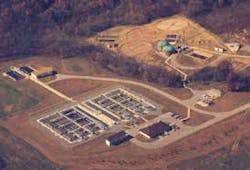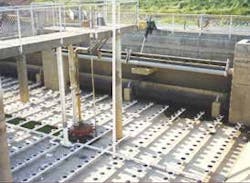Sanitaire ICEAS® SBR in Tullahoma, TN
In the late 1970s, the old Tullahoma, Tennessee wastewater treatment plant (WWTP), built in 1955, was overloaded and deteriorating. The city of Tullahoma and its consultants; Barge, Waggoner, Summer, and Cannon; began an extensive evaluation of different treatment options for the new plant, including oxidation ditch, in-channel clarifiers, and the Sanitaire Intermittent Cycle Extended Aeration System (ICEAS®) for a sequencing batch reactor (SBR) process.
After a trip to Australia to evaluate five existing ICEAS installations, the city of Tullahoma selected ICEAS because it was the most cost-effective wastewater treatment option and because of the technology’s ability to accommodate widely fluctuating infiltration loads without effluent degradation.
Solution
Developed in Australia in 1975, the Sanitaire ICEAS process is a continuous flow hybrid of the conventional fill and draw SBR process. Unlike conventional SBR systems, which discontinue flow during the settle and decant phase, the ICEAS basin continually receives raw wastewater throughout all phases of the treatment cycle. Short circuiting during the decant period is prevented by using a baffled, pre-react wall. The continuous flow feature of the ICEAS process typically results in a basin volume 25 to 30 percent smaller than that required by a conventional SBR.
The ICEAS process accomplishes the tasks of biological oxidation, nitrification, denitrification, phosphorous release and uptake, and solid/liquid separation in a single basin. The time-based operation of the ICEAS cycle is controlled automatically through a microprocessor. A typical cycle consists of three basic phases: aeration, settling, and decant. In certain applications, intermittent periods of aeration and anoxic mixing are combined to promote biological nutrient removal.
Though conceptually sophisticated, the ICEAS process is simple and elegant in operation. The ICEAS system uses a minimum of moving parts and powered components, since all flow from the ICEAS basin occurs by gravity. In addition, the entire stainless steel decanter requires no valves. During the decant period of the ICEAS cycle, the top layer of clarified water is discharged through a simple controlled weir type decanter. A pivoting scum float prevents any scum or floatables from being decanted with the treated water.
From 1993 to 1995, the Tullahoma plant was expanded and upgraded to accommodate high storm flows. The upgrade included additional piping and a new SCADA system; larger headworks, including a new bar screen and grit chamber; two 30 mgd screw pumps and a new pre-aeration basin; a new 48-million-gallon equalization basin; and an upgrade of the chlorine disinfection system. Under the new configuration, flows up to 15 million gallons per day (MGD) are received directly by the ICEAS basin. Flows in excess of 15 MGD are diverted to the equalization basin.
The 1993 plant upgrade also involved the retrofit of the original jet aeration system with a high efficiency Sanitaire fine bubble membrane grid aeration system.
Results
Despite a severe inflow and infiltration (I&I) problem and a higher than anticipated BOD load, the new plant met effluent BOD and TSS criteria within 20 days of its startup in 1985.
Today, the Tullahoma WWTP — the first in the United States to use the ICEAS process — continues to perform exceptionally well and has never exceeded permit requirements, even while operating up to 30 percent higher than its design flow capacity.
The plant consistently produces an ultra-high quality effluent with single digit effluent BOD5 and TSS concentrations and effluent NH3-N concentration less than 1 mg/l.
The elimination of the jet pumps reduced maintenance costs and saved over 3,000 kWh/day in energy use.
Editor's Note: Scranton Gillette Communications and the SGC Water Group are not liable for the accuracy, efficacy and validity of the claims made in this piece. The views expressed in this content do not reflect the position of the editorial teams of Water & Wastes Digest, Water Quality Products and Storm Water Solutions.

